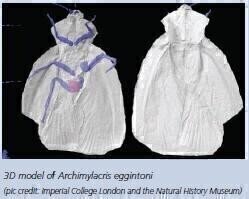News & Views
Cockroach Ancestor Revealed
May 24 2010
Scientists at Imperial College London have made a comprehensive 3D model of a fossilised specimen called Archimylacris eggintoni, an ancient ancestor of modern cockroaches, mantises and termites. This insect scuttled around on Earth during the Carboniferous period 359 - 299 million years ago, which was a time when life had recently emerged from the oceans to live on land.
The study reveals for the first time how Archimylacris eggintoni’s physical traits helped it to thrive on the floor of Earth’s early forests. The fossils of these creatures are normally between 2cm and 9cm in length and approximately 4cm in width.
The lead author of the study, Mr Russell Garwood, a PhD student from the Department of Earth Science and Engineering at Imperial College London, said:
“The Carboniferous period is sometimes referred to as the age of the cockroach because fossils of Archimylacris eggintoni and its relatives are amongst the most common insects from this time period. They are found all over the world. People joke about it being impossible to kill cockroaches and our 3D model almost brings this one back to life. Thanks to our 3D modelling process, we can see how Archimylacris eggintoni’s limbs were well adapted for all terrains, as it was not only adept in the air but also very agile on the ground.”
The researchers created their images using a CT scanning device, based at the Natural History Museum in London, which enabled them to take 3142 x-rays of the fossil and compile the images of the model; using powerful software these were then used to visualise the Archimylacris eggintoni’s legs, antennae, mouth parts and body, which had never been seen by human eyes before.
Mr Garwood added: “We now think this ancient ancestor of the cockroach spent most of the day on the forest floor, living in and eating lots of rotting plant and insect matter, which was probably the bug equivalent of heaven. We think it could have used its speed to evade predators and its climbing abilities to scale trees and lay eggs on leaves, much in the same way that modern forest cockroaches do today.”
The computer modelling technique will be used to study other fossilised creatures from the Carboniferous period such as spider-like creatures called the harvestmen and another species called Camptophyllia, which has yet to be classified by scientists.
Digital Edition
ILM 49.5 July
July 2024
Chromatography Articles - Understanding PFAS: Analysis and Implications Mass Spectrometry & Spectroscopy Articles - MS detection of Alzheimer’s blood-based biomarkers LIMS - Essent...
View all digital editions
Events
Jul 28 2024 San Diego, CA USA
Jul 30 2024 Jakarta, Indonesia
Jul 31 2024 Chengdu, China
ACS National Meeting - Fall 2024
Aug 18 2024 Denver, CO, USA
Aug 25 2024 Copenhagen, Denmark


.jpg)

24_06.jpg)













